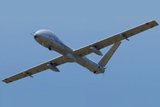NGJ-MB clears latest hurdle
An EA-18G Growler from Air Test and Evaluation Squadron 23 conducts a Next Generation Jammer Mid-Band flight test. (Photo: USN/Steve Wolff)
The Next Generation Jammer Mid-Band (NGJ-MB) programme for the USN has passed Milestone C tests, manufacturer Raytheon announced on 29 June.
This decision paves the way for NGJ-MB to enter the production and deployment phase and proceed with LRIP.
The USN and Royal Australian Air Force are each adopting NGJ-MB for their EA-18G Growler EW aircraft, to replace legacy ALQ-99 systems.
‘The Milestone C decision drives home the stability and maturity of NGJ-MB,’ said Annabel Flores, VP of electronic warfare systems at Raytheon Intelligence & Space.
She added: ‘The system is ready for validation and LRIP, and we’re gearing up for the delivery of this critical capability to the fleet.’
To date, NGJ-MB has successfully completed more than 145h of developmental flight testing using mission systems and aeromechanical pods.
NGJ-MB has also completed more than 3,100h of anechoic chamber and laboratory tests to evaluate its performance both on and off the EA-18G Growler aircraft, in addition to jamming techniques and reliability testing.
A total of 28 NGJ-MB pods will be delivered in the engineering, manufacturing and development phase, Shephard Defence Insight reports.
Related Equipment in Defence Insight
More from Air Warfare
-
![Singapore’s Hermes 900 buy to enhance multi-domain ISR capabilities]()
Singapore’s Hermes 900 buy to enhance multi-domain ISR capabilities
Drawing on its endurance and substantial payload capacity, the Hermes 900 would provide a boost to Singapore’s ISR capabilities, particularly in the maritime domain.
-
![Dubai Airshow 2025: GA-ASI’s MQ-9B racks up new milestones with AEW demo planned]()
Dubai Airshow 2025: GA-ASI’s MQ-9B racks up new milestones with AEW demo planned
The company announced its demonstration timeline while confirming the MQ-9B had completed the platform’s third lifetime test.
-
![Dubai Airshow 2025: Edge Group eyes international market expansion, unveils new UAVs]()
Dubai Airshow 2025: Edge Group eyes international market expansion, unveils new UAVs
The UAV portfolio expansion comes in the wake of the Edge-Anduril joint venture announced ahead of the airshow.
-
![India reopens hunt for reconnaissance and surveillance helicopters]()
India reopens hunt for reconnaissance and surveillance helicopters
The extended deadline for vendors highlights the complexity of the procurement for India, with numerous vendors positioning themselves for the programme.
-
![European firms express interest in filling NATO airborne early warning replacement needs]()
European firms express interest in filling NATO airborne early warning replacement needs
The comments from both Saab and Airbus on their potential to fulfil the airborne early warning and control requirement come after NATO countries shelved plans to procure six E-7 Wedgetail AEW&C aircraft.
-
![Dubai Airshow 2025: Lockheed’s AGM-158 XR flight tests planned for 2026]()
Dubai Airshow 2025: Lockheed’s AGM-158 XR flight tests planned for 2026
The AGM-158 XR, which started as a Lockheed Martin internal investment, was first unveiled in September 2024.
























